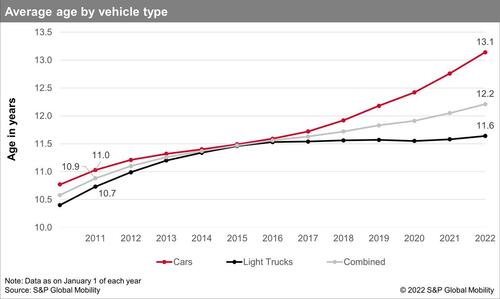See other National News Articles
Title: Average Age Of Vehicles On US Highways Keeps Getting Older
Source:
[None]
URL Source: https://www.zerohedge.com/markets/a ... s-highways-keeps-getting-older
Published: May 23, 2022
Author: Tyler Durden
Post Date: 2022-05-23 22:12:08 by Horse
Keywords: None
Views: 133
Comments: 6
The average age of vehicles on US highways rose for the fifth consecutive year and to a record high, as supply-chain disruptions and inventory challenges prompt owners to hold on to their cars and trucks longer, according to research from S&P Global Mobility. Semiconductor shortages and inventory challenges were the top drivers in pushing US average vehicle age to 12.2 years, another all-time high. Chip supply constraints have caused continued parts shortages for carmakers, who have been forced to cut production. The constrained supply of new cars and light trucks, amid a strong demand for personal transportation, could have influenced consumers to continue operating their existing vehicles longer, as inventory levels for both new and used vehicles were depleted across the industry. - S&P Global Mobility The finding reflects that used car life cycles are being extended because new vehicle supplies are tight. Kelley Blue Book recorded average new car prices at $46,526 in April, another obstacle for prospective buyers. Despite used car prices reversing from lofty levels, they remain out of reach for many, thus consumers are holding on to their vehicles longer. About a decade ago, a used vehicle with over 100,000 miles would've been deemed a lemon by a consumer, though now, it's common to see multiple owners for one with 200,000 miles. The increasing average vehicle age and higher mileage point to a "notable increase in repair revenue in the coming year," Todd Campau, associate director of aftermarket solutions at S&P Global Mobility, told Bloomberg. There's reason to believe the average age of vehicles on US highways will continue marching higher as tight supplies of new and used cars have sparked an unaffordability crisis. Poster Comment: Americans will soon be hit with new car bills they cannot afford. 
Post Comment Private Reply Ignore Thread
Top • Page Up • Full Thread • Page Down • Bottom/Latest
#1. To: Horse, 4um (#0)
(Edited)
A few months ago, I put over $4,000 into a '93 GMC p/u with only ~58,000 on the clock for my Godson. Two years ago, the KBB value was $800. I'm told it's worth about $12k now. In 1979 I bought a 1980 Z28 Camaro off the dealer's showroom floor. Sticker price was about $8,000. I'm sure I didn't pay sticker. I tuned that thing up nice after desmogging it. Between the big-ass pancake pellet type catalyst and the bullshit air pump hardware, I probably shaved a hundred pounds off that bitch. That catalyst is probably worth a fortune now.
Most of the vehicles I've owned have been at least marryin' age.
Red truck that I gave Sling Blade was an old girl, old enough to go out drinkin' with me, and she did. When I brought her back from Chip's after head surgery, I forgot how tight she was. My 10 y/o Japanese girl is tubby compared to Red. My last truck was a '95 Chevy with a 350 TBI. Nice but the steering had too much play and the turning radius was too wide. Sold it when a head gasket started leaking. Could have fixed it, but it was time to upgrade a little anyway. My 2002 Silverado has much tighter steering (rack type) and much tighter turning radius. Direct injection works OK, but TBI was just as good.
Red had the 4.3 V6 TBI automatic. I could've gone through tires weekly, if so inclined. My fat 2013 Jap girl has the std 4, auto, manual windows, doorlocks. My late digit bender buddy called it "quaint" when he saw it the first time. Americans will soon be hit with new car bills they cannot afford.
TRUE TERROR will arrive at these people’s door, and they will cry, scream, and beg for mercy…
but it will fall upon the deaf ears of the Men who just wanted to be left alone.”
#2. To: All (#1)
TRUE TERROR will arrive at these people’s door, and they will cry, scream, and beg for mercy…
but it will fall upon the deaf ears of the Men who just wanted to be left alone.”
#3. To: Esso (#1)
#4. To: StraitGate (#3)
Most of the vehicles I've owned have been at least marryin' age.
TRUE TERROR will arrive at these people’s door, and they will cry, scream, and beg for mercy…
but it will fall upon the deaf ears of the Men who just wanted to be left alone.”
#5. To: Esso (#4)
#6. To: StraitGate (#5)
TRUE TERROR will arrive at these people’s door, and they will cry, scream, and beg for mercy…
but it will fall upon the deaf ears of the Men who just wanted to be left alone.”
Top • Page Up • Full Thread • Page Down • Bottom/Latest